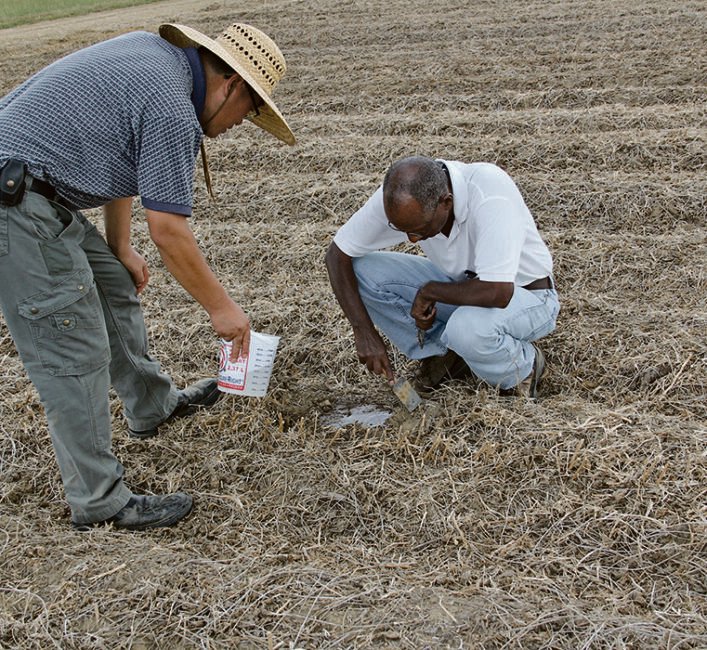Poultry litter’s efficiency as fertilizer studied

Researchers discovered a significant positive impact on soil, which was less compacted and could hold much more water
Every year, poultry farmers raise millions of broiler chickens, turkeys and laying hens, and in 2019 Canadian chicken production generated $2.8 billion.
Along with all the meat and eggs comes millions of tonnes of poultry litter. Much of it is spread on crops as fertilizer.
While this practice is convenient, scientists at Mississippi State University are questioning how effective poultry litter really is as a soil fertilizer.
Poultry litter is made up of bird manure and bedding.
In response to questions from farmers in the state, scientists launched a soils study and applied poultry litter to test fields over several years. They then grew crops. The litter came from the same supplier and was consistent in analysis, although it was not necessarily from the same chicken farm.
The study began in 2010 and, over a five-year period, researchers applied poultry litter to one test field, commercial fertilizer to a second test field, and left a third control field neutral with no nutrients.
The total land area was about 3.5 acres. Each subplot had four 25.4-metre-long rows with 0.97 metres of space between the rows. Consecutive subplots were separated by two 0.97 metre buffer rows.
After five years of fertilizer management treatments, they planted soybeans for three years. At the end of the eight-year period, they tested the soils to see what had given the greatest impact. The study is on-going.
“Our goals were to develop sustainable management practices and guide farmers on best ways to increase row crop production while keeping nutrients in the field and improving soil health,” said Gary Feng, soil scientist with the U.S. Department of Agriculture and a member of the Soil Science Society of America.
Results showed that poultry litter had a significant positive impact on soil. It was less compacted and could hold a lot more water. The litter allowed water to soak into the ground more quickly.
“The infiltration rate and saturated hydraulic conductivity, indicating how fast water can soak through soil and be absorbed, was two to three times greater in soil amended with poultry litter than with inorganic fertilizer,” said Feng. “Poultry litter addition significantly increased field capacity and plant-available water content (holding more water for plant use) by 20 percent. It is because of applying poultry litter that it significantly reduced bulk density (loose soil) and improved soil aggregate stability. I believe litter helps with water retention by improving soil’s physical properties.”
According to a news release, the upshot was that soil receiving poultry litter could save farmers about one watering event a season, meaning money and time saved for farmers working irrigated fields.
Feng said that the most valuable nutrient of the poultry litter would depend on the soil to which it was applied. If the soil is deficient in potassium, then that would be the most valuable nutrient. If the soil benefits most from organic matter, then that is the most valuable aspect of the litter.
“Poultry litter addresses multiple soil issues at the same time and so it is a very valuable material,” he said.
An important component of soil is the amount of carbon it retains since carbon-based organic matter will improve soil. Tracking soil carbon gave the scientists insight into greenhouse gases.
The results provided a basis for developing guidelines for greenhouse gas emission predictions and for realistic expectations of soil carbon improvement after applying poultry litter.
“The results showed that simulated CO2 emissions from soil fertilized with litter averaged across the years was approximately 0.8 times higher than soil fertilized with NH4NO3 (ammonium nitrate),” said Feng.
The study pointed to a clear value of poultry litter to both crop farmers and poultry farmers. The findings may help crop farmers make fertilizer decisions and poultry farmers have a clearer picture of the value of their byproduct.
The positive response has underscored the importance of continued research.
“We will continuously investigate soil’s physical and hydrological properties as affected not only by poultry litter, but also combining cover crop and other promising organic amendments as well as management practices,” said Feng. “The purpose is to find different ways (timing, rate, combination of other practices) for maximizing soil chemical, physical, hydrological and biological health and improving crop yields.”
Soybeans planted in the test fields produced better yields in the years following the addition of poultry litter. One year later, soybean yields were eight percent higher and three years later they were 11 percent higher than in fields treated with synthetic fertilizers.
“Leftover nutrients from litter in the previous consecutive application can maintain higher soybean yield for three more years after stopping litter application,” he said.
The results of the study based on data from 2015 and 2017 were published recently in Soil Science Society of America Journal.
Source: www.producer.com

